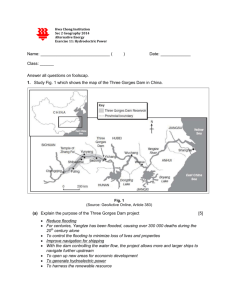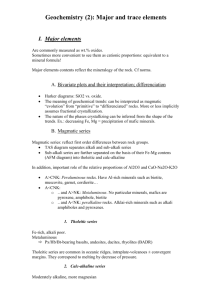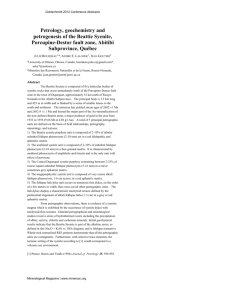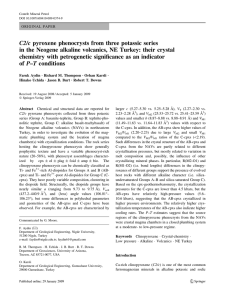rectina - Geolines
advertisement
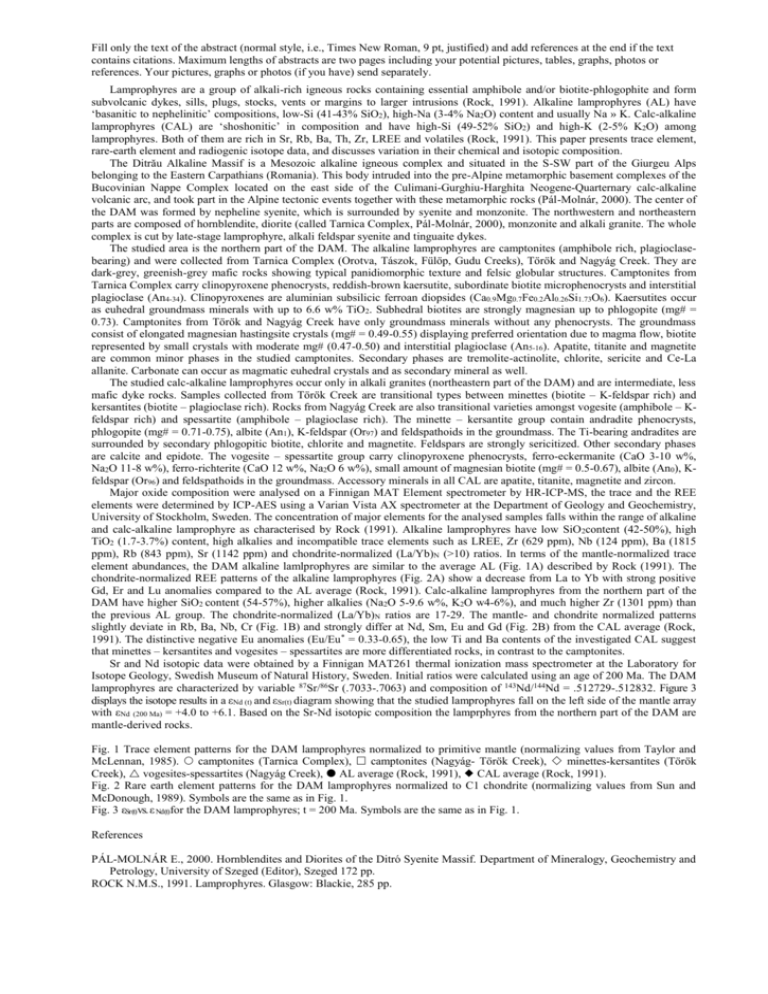
Fill only the text of the abstract (normal style, i.e., Times New Roman, 9 pt, justified) and add references at the end if the text contains citations. Maximum lengths of abstracts are two pages including your potential pictures, tables, graphs, photos or references. Your pictures, graphs or photos (if you have) send separately. Lamprophyres are a group of alkali-rich igneous rocks containing essential amphibole and/or biotite-phlogophite and form subvolcanic dykes, sills, plugs, stocks, vents or margins to larger intrusions (Rock, 1991). Alkaline lamprophyres (AL) have ‘basanitic to nephelinitic’ compositions, low-Si (41-43% SiO2), high-Na (3-4% Na2O) content and usually Na » K. Calc-alkaline lamprophyres (CAL) are ‘shoshonitic’ in composition and have high-Si (49-52% SiO2) and high-K (2-5% K2O) among lamprophyres. Both of them are rich in Sr, Rb, Ba, Th, Zr, LREE and volatiles (Rock, 1991). This paper presents trace element, rare-earth element and radiogenic isotope data, and discusses variation in their chemical and isotopic composition. The Ditrău Alkaline Massif is a Mesozoic alkaline igneous complex and situated in the S-SW part of the Giurgeu Alps belonging to the Eastern Carpathians (Romania). This body intruded into the pre-Alpine metamorphic basement complexes of the Bucovinian Nappe Complex located on the east side of the Culimani-Gurghiu-Harghita Neogene-Quarternary calc-alkaline volcanic arc, and took part in the Alpine tectonic events together with these metamorphic rocks (Pál-Molnár, 2000). The center of the DAM was formed by nepheline syenite, which is surrounded by syenite and monzonite. The northwestern and northeastern parts are composed of hornblendite, diorite (called Tarnica Complex, Pál-Molnár, 2000), monzonite and alkali granite. The whole complex is cut by late-stage lamprophyre, alkali feldspar syenite and tinguaite dykes. The studied area is the northern part of the DAM. The alkaline lamprophyres are camptonites (amphibole rich, plagioclasebearing) and were collected from Tarnica Complex (Orotva, Tászok, Fülöp, Gudu Creeks), Török and Nagyág Creek. They are dark-grey, greenish-grey mafic rocks showing typical panidiomorphic texture and felsic globular structures. Camptonites from Tarnica Complex carry clinopyroxene phenocrysts, reddish-brown kaersutite, subordinate biotite microphenocrysts and interstitial plagioclase (An4-34). Clinopyroxenes are aluminian subsilicic ferroan diopsides (Ca0.9Mg0.7Fe0.2Al0.26Si1.73O6). Kaersutites occur as euhedral groundmass minerals with up to 6.6 w% TiO2. Subhedral biotites are strongly magnesian up to phlogopite (mg# = 0.73). Camptonites from Török and Nagyág Creek have only groundmass minerals without any phenocrysts. The groundmass consist of elongated magnesian hastingsite crystals (mg# = 0.49-0.55) displaying preferred orientation due to magma flow, biotite represented by small crystals with moderate mg# (0.47-0.50) and interstitial plagioclase (An5-16). Apatite, titanite and magnetite are common minor phases in the studied camptonites. Secondary phases are tremolite-actinolite, chlorite, sericite and Ce-La allanite. Carbonate can occur as magmatic euhedral crystals and as secondary mineral as well. The studied calc-alkaline lamprophyres occur only in alkali granites (northeastern part of the DAM) and are intermediate, less mafic dyke rocks. Samples collected from Török Creek are transitional types between minettes (biotite – K-feldspar rich) and kersantites (biotite – plagioclase rich). Rocks from Nagyág Creek are also transitional varieties amongst vogesite (amphibole – Kfeldspar rich) and spessartite (amphibole – plagioclase rich). The minette – kersantite group contain andradite phenocrysts, phlogopite (mg# = 0.71-0.75), albite (An1), K-feldspar (Or97) and feldspathoids in the groundmass. The Ti-bearing andradites are surrounded by secondary phlogopitic biotite, chlorite and magnetite. Feldspars are strongly sericitized. Other secondary phases are calcite and epidote. The vogesite – spessartite group carry clinopyroxene phenocrysts, ferro-eckermanite (CaO 3-10 w%, Na2O 11-8 w%), ferro-richterite (CaO 12 w%, Na2O 6 w%), small amount of magnesian biotite (mg# = 0.5-0.67), albite (An0), Kfeldspar (Or96) and feldspathoids in the groundmass. Accessory minerals in all CAL are apatite, titanite, magnetite and zircon. Major oxide composition were analysed on a Finnigan MAT Element spectrometer by HR-ICP-MS, the trace and the REE elements were determined by ICP-AES using a Varian Vista AX spectrometer at the Department of Geology and Geochemistry, University of Stockholm, Sweden. The concentration of major elements for the analysed samples falls within the range of alkaline and calc-alkaline lamprophyre as characterised by Rock (1991). Alkaline lamprophyres have low SiO 2content (42-50%), high TiO2 (1.7-3.7%) content, high alkalies and incompatible trace elements such as LREE, Zr (629 ppm), Nb (124 ppm), Ba (1815 ppm), Rb (843 ppm), Sr (1142 ppm) and chondrite-normalized (La/Yb)N (>10) ratios. In terms of the mantle-normalized trace element abundances, the DAM alkaline lamlprophyres are similar to the average AL (Fig. 1A) described by Rock (1991). The chondrite-normalized REE patterns of the alkaline lamprophyres (Fig. 2A) show a decrease from La to Yb with strong positive Gd, Er and Lu anomalies compared to the AL average (Rock, 1991). Calc-alkaline lamprophyres from the northern part of the DAM have higher SiO2 content (54-57%), higher alkalies (Na2O 5-9.6 w%, K2O w4-6%), and much higher Zr (1301 ppm) than the previous AL group. The chondrite-normalized (La/Yb)N ratios are 17-29. The mantle- and chondrite normalized patterns slightly deviate in Rb, Ba, Nb, Cr (Fig. 1B) and strongly differ at Nd, Sm, Eu and Gd (Fig. 2B) from the CAL average (Rock, 1991). The distinctive negative Eu anomalies (Eu/Eu* = 0.33-0.65), the low Ti and Ba contents of the investigated CAL suggest that minettes – kersantites and vogesites – spessartites are more differentiated rocks, in contrast to the camptonites. Sr and Nd isotopic data were obtained by a Finnigan MAT261 thermal ionization mass spectrometer at the Laboratory for Isotope Geology, Swedish Museum of Natural History, Sweden. Initial ratios were calculated using an age of 200 Ma. The DAM lamprophyres are characterized by variable 87Sr/86Sr (.7033-.7063) and composition of 143Nd/144Nd = .512729-.512832. Figure 3 displays the isotope results in a εNd (t) and εSr(t) diagram showing that the studied lamprophyres fall on the left side of the mantle array with εNd (200 Ma) = +4.0 to +6.1. Based on the Sr-Nd isotopic composition the lamprphyres from the northern part of the DAM are mantle-derived rocks. Fig. 1 Trace element patterns for the DAM lamprophyres normalized to primitive mantle (normalizing values from Taylor and McLennan, 1985). camptonites (Tarnica Complex), camptonites (Nagyág- Török Creek), minettes-kersantites (Török Creek), vogesites-spessartites (Nagyág Creek), AL average (Rock, 1991), CAL average (Rock, 1991). Fig. 2 Rare earth element patterns for the DAM lamprophyres normalized to C1 chondrite (normalizing values from Sun and McDonough, 1989). Symbols are the same as in Fig. 1. Fig. 3 εSr(t)vs. ε Nd(t)for the DAM lamprophyres; t = 200 Ma. Symbols are the same as in Fig. 1. References PÁL-MOLNÁR E., 2000. Hornblendites and Diorites of the Ditró Syenite Massif. Department of Mineralogy, Geochemistry and Petrology, University of Szeged (Editor), Szeged 172 pp. ROCK N.M.S., 1991. Lamprophyres. Glasgow: Blackie, 285 pp. Fill only the text of the abstract (normal style, i.e., Times New Roman, 9 pt, justified) and add references at the end if the text contains citations. Maximum lengths of abstracts are two pages including your potential pictures, tables, graphs, photos or references. Your pictures, graphs or photos (if you have) send separately. SUN S.S. and MCDONOUGH W.F., 1989. Chemical and isotopic systematics of oceanic basalts: implications for mantle composition of the earth and mantle evolution. In: Saunders A.D., Norry M.J. (Editors), Magmatism in Ocean Basins. Geol. Soc. Spec. Publ. 41, pp. 313-345. TAYLOR S.R. and MCLENNAN S.M., 1985. The continental crust: its composition and evolution. Blackwell, Oxford, 312 pp.

